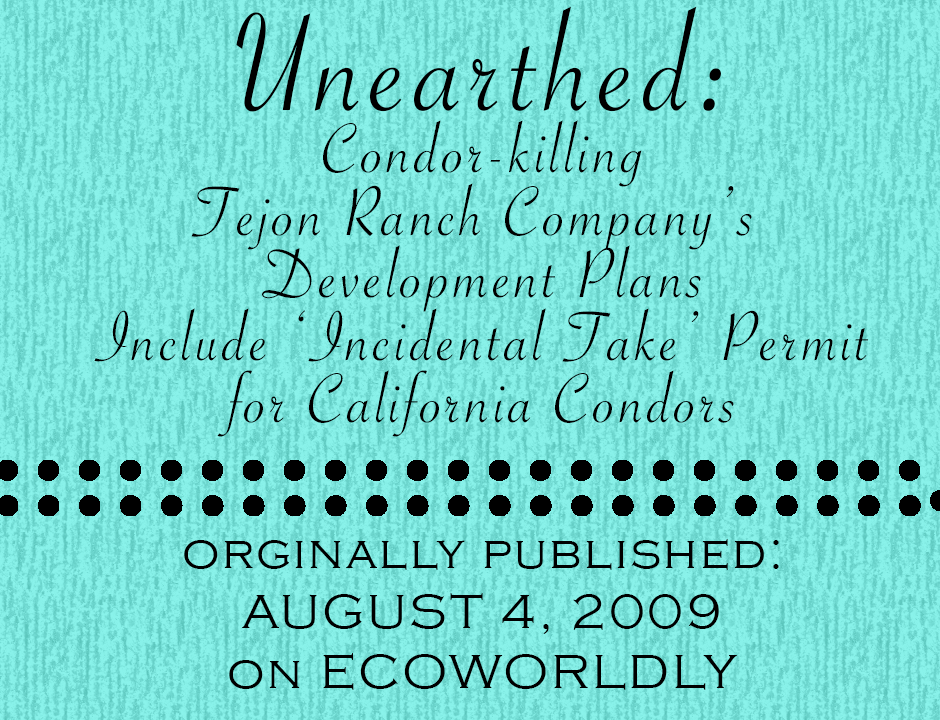
A luxury-home subdivision in the heart of designated California Condor habitat?
That’s exactly what Tejon Ranch Company (TRC) has in mind.
In fact, Tejon Ranch Company (TRC) has had it in for the California Condors since at least 1997. That’s when they sued the U.S. Fish and Wildlife Service to prevent the reintroduction of the species into Southern California.
Why would Tejon Ranch Company (TRC) be opposed to the reintroduction of California Condors?
Because TRC would be prevented from developing any land that is designated California Condor habitat. And if a publicly traded real estate development company can’t develop real estate …. well, then they can’t make a profit.
In fact, TRC has gone to tremendous lengths to push their development deal through. Under the cloak of a
“habitat conservation plan” – to mitigate “incidental take” of threatened or endangered species – they even finagled the support of major environmental organizations, like the Sierra Club.
“Sweetheart deal”?
What is puzzling to conservation groups, such as the Center for Biological Diversity, is that when TRC filed the lawsuit, the FWS “rushed” to the settlement table, without attempting to defend the condors.
According to the Center for Biological Diversity:
Tejon’s legal arguments, although arguably specious and at best very weak, were not seriously opposed by the government, which instead settled the case for what is believed to be a sweetheart deal that has resulted in the current plan and take-permit application.
TRC’s habitat conservation plan and “incidental take” application
TRC, in order to be granted permission to develop the luxury community, has had to file an application for what is called a “Habitat Conservation Plan (HCP) and Incidental Take Permit” from the FWS.
According to the FWS, if your activities are going to result in the “take” of threatened or endangered species, a “habitat conservation plan” must be submitted in order for you to be granted the “right” to “take” threatened or endangered species.
An incidental take permit is required when non-Federal activities will result in “take” of threatened or endangered wildlife. A habitat conservation plan (HCP) must accompany an application for an incidental take permit. The purpose of the habitat conservation planning process associated with the permit is to ensure there is adequate minimizing and mitigating of the effects of the authorized incidental take. The purpose of the incidental take permit is to authorize the incidental take of a listed species, not to authorize the activities that result in take … “Take” is defined in the Endangered Species Act (ESA) as harass, harm, pursue, hunt, shoot, wound, kill, trap, capture, or collect any threatened or endangered species. Harm may include significant habitat modification where it actually kills or injures a listed species through impairment of essential behavior (e.g., nesting or reproduction).
In other words, the only reason Tejon Ranch Company filed a “habitat conservation plan” was because they already know the development of their luxury mountain village is going to result in the “take” of endangered species. Such as California Condors.
And it looks like TRC has even built an elaborate marketing campaign around the “habitat conservation plan.”
“Monaco in the mountains”
The driving force behind all this is TRC’s proposed development of Tejon Mountain Village, a luxury-home subdivision planned for the heart of designated critical California Condor habitat.
Recently, I spoke with Adam Keats, urban wildlands program director at the Center for Biological Diversity about this issue.
What they are trying to do is build a ‘Monaco in the mountains’. They want to build clusters of homes connected by paths throughout the habitat. Of course, the condors aren’t going to go anywhere near these ‘home pods.’ And what this will do is fragment the condors’ habitat.
Mr. Keats also pointed out that the natural food of condors – rotting carcasses – would become scarce around Tejon Mountain Village, noting that homeowners would be likely to call the authorities to dispose of any dead animals, depriving condors of any opportunities to feed naturally.
“Protecting” Tejon Ranch?
In exchange for the support of “major environmental organizations”, TRC created what they call the “Tejon Ranch Conservation and Land Use Agreement.”
This is essentially an agreement that the environmentalists – called “Resource Groups” – will go along with TRC’s development plans in exchange for “conservancy pledges.”
Acquired Conservation Areas. TRC will provide separate options for the Resource Groups to purchase development rights through acquisition of conservation easements, or potentially a fee interest, for five (5) separate Acquisition Areas, totaling an additional 62,000 acres.
Non-Opposition. The Resource Groups will refrain from opposing the entitlement and permit applications and approvals for the three development projects.
It’s all right here in the “Tejon Ranch Conservation and Land Use Agreement Summary of Key Provisions.”1
A Schwarzenegger-approved way to “pump up our economy”
Yes, even Governor Arnold Schwarzenegger is on board with TRC’s plan:
The success of environmental organizations and Tejon Ranch Co. in reaching this historic agreement to protect a California treasure illustrates something that I have stressed since taking office — we can protect California’s environment at the same time we pump up our economy.
Is timing everything?
TRC has been trying to keep the public out of the development process since the beginning by filing a protective order with its own lawsuit against the FWS.
But now, they are lifting the protective order, saying in a press release it is at the request of three of the
“Resource Groups” named in the Land Use Agreement.2
Three of those organizations, Natural Resources Defense Council, Sierra Club and Audubon California, recently contacted Tejon Ranch to express concern that the Protective Order could create the appearance of nondisclosure, something contrary to the very comprehensive science-based negotiations that led to the historic agreement.
However, the lifting of the order comes nearly a month after the Fish and Wildlife Service stopped accepting comments on the “habitat conservation plan and incidental take permit”, ensuring that the public would have no voice in the issue.
It also happens that on June 11, 2009, the Center for Biological Diversity informed the Fish and Wildlife Service that its continued withholding of the documents was a violation of the Endangered Species Act:
…information received by the [Fish and Wildlife Service] as a part of any application [for a “take permit,” which allows the harming, harassing, or killing of protected species] shall be available to the public as a matter of public record at every stage of the proceeding.
and that the Center would file suit in 60 days to halt the review process for the draft plan.
It just so happens the 60 days is up next week.
“Tejon Ranch’s timing is remarkably convenient,” said Adam Keats, urban wildlands program director at the Center.
“For seven years straight, the corporation has prevented these documents from seeing the light of day. Only now, after the door has been slammed shut on the public process, does it seek to release them to the public. But the lawsuit Tejon filed to prevent the successful reintroduction of the California condor remains active, poised like a gun to the head of the agency that’s reviewing the company’s application.”
California Condor population
There are only 358 California Condors left in the world. 169 are in captivity, and 189 are flying free.
You can visit Save Tejon Ranch for additional California Condor information.
- http://www.tejonpreserve.com/summary.php
- http://tejonranch.com/news/company_news_preview.asp?pid=79
Thanks to the Center for Biological Diversity for including this article in News Archives.
